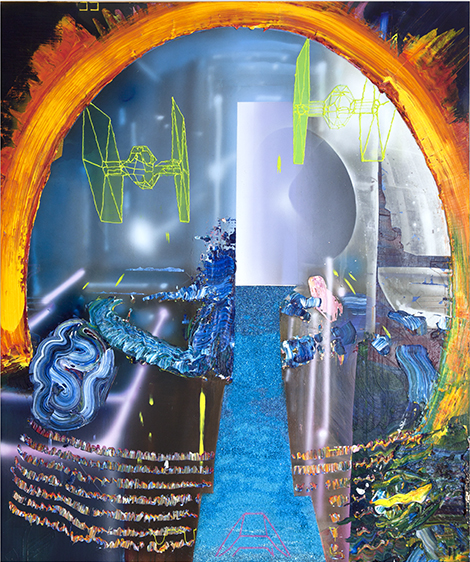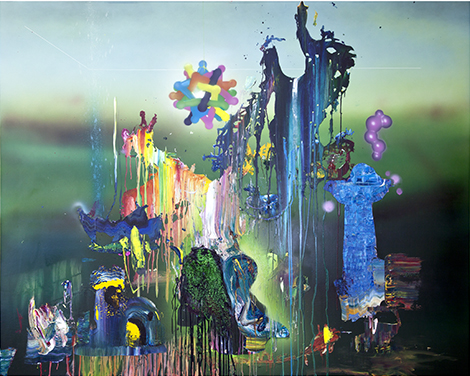I try to avoid reading too much into titles of paintings because they can rarely be more than the most tenuous captions for something effectively functioning in a language of its own. Occasionally a show’s title underscores a certain theme resonating through the work—but the title of Tom LaDuke’s most recent show, “Candles and Lasers,” at the Kohn Gallery, frustrates this with deliberate ambiguity. The depths and shallows of these works (I’m borrowing from one of LaDuke’s own titles here) may disclose elements with a laser’s pinpoint illumination or a candle’s glow, but mostly they float over an airbrushed underpainting that backlights the surface.
LaDuke’s titles, though no less trustworthy than that of most artworks, are deliberately provocative. It’s not only in the above-referenced The Depths and the Shallows (2015) that LaDuke moves the viewer toward considerations of the ambiguities of surface (and depth) treatments, translucency, opacity, illusionism, expression, trompe l’oeil, decoration (and alternatively, scraping, tearing, stripping away—the explicit break or violation of surface). LaDuke hews to a well-established procedure—laying out a precisely rendered copy of a canonic representational painting, airbrushing over it, and playing over this ground with motives variously abstract and figurative.
In other paintings, figurative/representational elements are asserted on the surface. In lap, trickle, lap, what might be a polymorphic “Birth of Venus” is fashioned from a mash-up of dissonantly abstract and trompe l’oeil elements. In some instances, LaDuke has all but made such frustration the subject of the work, with titles that reference specific objects or phenomena in the culture or physical world (e.g., Holley Manifold—an actual engine air-intake component, or Polyrhythmic Looping (2014), which refers to looping multiple rhythm tracks in electronic music). There are subtle exceptions—and here the conjunction of titles and imagery may simply elicit a sigh—e.g., Gloryhole (2015), in which a sweeping arch of continuous bright orange and yellow brushstrokes circles a quasi-celestial airbrushed void replete with river of glitter and ‘laser’-etched satellites that may be cribbed from Leonardo or a video game; or Audio Mirror (2015) with its “caged” owl silhouette and variously expressionist and illusionist bird imagery.
LaDuke veils the “model” or “template,” only to brush, etch, drip, scratch it out over a painting’s surface. That may be a ghost Pontiac heading our way through the rainbow and straight into a large blue tree in French Cemetery (2015)—but nothing stays buried here. The dominant affect throughout is distrust.
LaDuke’s sculptures are surprisingly more revealing of the artist as vessel and instrument of his visions. In Oceans (2015) LaDuke places a slightly scaled-down pewter replica of his head as if asleep atop a boulder, as his Renaissance lace collar unravels and melts into the rock. A faceted crystal drop protrudes from one side of the rock, slyly mocking parallels to heroic legend. The dislocated limb in Clearing traverses a space between death and “hereafter,” corruption and void. There’s a lightness, even lyricism to both objects we could never get from the painting. But we can trust that what’s behind it is very dark.



